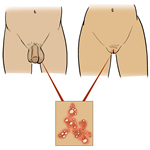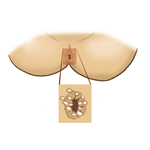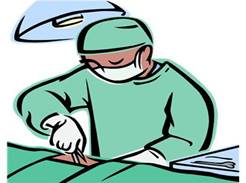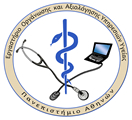Symptoms
In many cases the HPV virus produces no symptoms and people who have contracted an HPV infection do not know they have it!
 1. One or multiple, small or large, raised or flat, or shaped like a cauliflower, bumps in the genital area and around the anus (genital warts – condylomata). 1. One or multiple, small or large, raised or flat, or shaped like a cauliflower, bumps in the genital area and around the anus (genital warts – condylomata).
|
| |
 2. Cervical lesions 2. Cervical lesions
|
Genital warts are one of the most common sexually transmitted infections. The virus affects the genital area, the mouth and throat of both women and men. Sometimes the infection persists and may cause a series of severe health problems (e.g. cancer of the uterus, of the genitalia, of the oropharynx, etc.)
Transmission


The virus is usually transmitted through sexual intercourse (vaginal, anal). The virus can be passed during oral sex and through skin-to-skin genital contact of the partners. It can happen to anyone, even to persons with long-term monogamous relationships or with only one lifetime sex partner. The person infected with the virus may not present any symptoms. Most people do not know that they are infected or that they spread the virus. An infected person may have the virus many years after infection. Also, in rare cases, the virus can be transmitted from a pregnant mother to her baby during childbirth.
Treatment

In order to treat the disease, seek medical assistance. Most infections resolve spontaneously within 2 years. The HPV virus itself cannot be treated. There are however treatment options focusing on the problems created by the virus:
-
Τhe genital warts can be surgically removed. If left untreated, they may resolve spontaneously, remain as they are or grow in size or number.
-
Uterine cancer may be successfully treated if diagnosed early. In women who get Pap tests regularly, uterine cancer may be prevented.
-
Other types of cancer associated with the virus can also be cured if diagnosed early.
-
Condylomata in the throat may be treated surgically or with pharmaceutical treatment.
Prevention
-
Vaccination
-
Not having sex is the only sure way to avoid HPV
-
A mutually committed monogamous relationship with a partner that has been tested and is not infected
-
The consistent and correct use of a condom in all sexual activity, from start to finish, with every sex partner reduces, however it does not rule out your possibility to get the infection. The condom protects only the areas covered!
-
Talk freely and openly with your partner about the human papilloma virus and other sexually transmitted diseases
When to seek medical advice
Seek medical advice if:
-
you develop symptoms such as warts in the genital area
-
your partner presents genital warts, even if you do not have the symptoms
Vaccines
Τhe quadrivalent (HPV4) or the bivalent (HPV2) vaccine are recommended to women for the prevention of precancerous and cancerous lesions of the uterine cervix. Furthermore, HPV4 also protects from genital warts. HPV4 is approved for administration to persons from 9 to 45 years, and HPV2 from 10 to 26 years. In our country, it is administered free of charge to girls and women from 12 to 26 years.
References
cdc
National Immunization Program for Children and Adolescents 2011



















